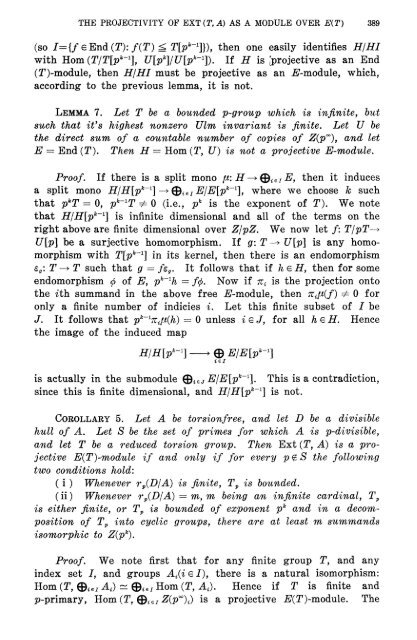The projectivity of Ext(T,A) as a module over E(T) - MSP
The projectivity of Ext(T,A) as a module over E(T) - MSP
The projectivity of Ext(T,A) as a module over E(T) - MSP
You also want an ePaper? Increase the reach of your titles
YUMPU automatically turns print PDFs into web optimized ePapers that Google loves.
THE PROJECTIVITY OF EXT (T, A) AS A MODULE OVER E(T) 389<br />
(so J={/eEnd(Γ):/(Γ)^ Tb*" 1 ]}), then one e<strong>as</strong>ily identifies H/HI<br />
with Horn (Γ/ΓIp*" 1 ], UΪPI/I/IP*" 1 ]). If -ff is [protective <strong>as</strong> an End<br />
(T)-<strong>module</strong>, then H/HI must be protective <strong>as</strong> an J^-<strong>module</strong>, which,<br />
according to the previous lemma, it is not.<br />
LEMMA 7. Let T be a bounded p-group which is infinite, but<br />
such that it's highest nonzero Vim invariant is finite. Let U be<br />
the direct sum <strong>of</strong> a countable number <strong>of</strong> copies <strong>of</strong> Z{p°°), and let<br />
E = End (Γ). <strong>The</strong>n H = Horn (T, U) is not a protective E-<strong>module</strong>.<br />
Pro<strong>of</strong>. If there is a split mono μ: H-+@ ieI<br />
E, then it induces<br />
a split mono H/H[p k ~ 1 ]-*φ ieI<br />
E/E[p k ~ 1 ], where we choose k such<br />
that p k T = 0, p^T Φ 0 (i.e., p k<br />
is the exponent <strong>of</strong> T). We note<br />
that H/H[p k ~ x ] is infinite dimensional and all <strong>of</strong> the terms on the<br />
right above are finite dimensional <strong>over</strong> Z/pZ. We now let /: T/pT~><br />
U[p] be a surjective homomorphism. If g: T —> U[p] is any homomorphism<br />
with Tip 16 " 1 ] in its kernel, then there is an endomorphism<br />
ε g<br />
: T -> Γ such that g = fε g<br />
. It follows that if heH, then for some<br />
endomorphism φ <strong>of</strong> E, p^h = fφ. Now if TΓ; is the projection onto<br />
the ΐth summand in the above free £7-<strong>module</strong>, then π t<br />
μ(f) Φ 0 for<br />
only a finite number <strong>of</strong> indicies i. Let this finite subset <strong>of</strong> / be<br />
J. It follows that p^n^Qi) = 0 unless i e J, for all heH. Hence<br />
the image <strong>of</strong> the induced map<br />
is actually in the sub<strong>module</strong> ® ie<br />
j E/E[p k 1 ], This is a contradiction,<br />
since this is finite dimensional, and H/Hlp 16 ' 1 ] is not.<br />
COROLLARY 5. Let A be torsionfree, and let D be a divisible<br />
hull <strong>of</strong> A. Let S be the set <strong>of</strong> primes for which A is p-divisible,<br />
and let T be a reduced torsion group. <strong>The</strong>n <strong>Ext</strong> (Γ, A) is a projective<br />
E(T)-<strong>module</strong> if and only if for every pi S the following<br />
two conditions hold:<br />
(i ) Whenever r p<br />
(D/A) is finite, T p<br />
is bounded.<br />
(ii) Whenever r p<br />
(D/A) = m f<br />
m being an infinite cardinal, T p<br />
is either finite, or T p<br />
is bounded <strong>of</strong> exponent p k<br />
and in a decomposition<br />
<strong>of</strong> T p<br />
into cyclic groups, there are at le<strong>as</strong>t m summands<br />
isomorphic to Z(p k ).<br />
Pro<strong>of</strong>. We note first that for any finite group T, and any<br />
index set /, and groups A t<br />
(ί e I), there is a natural isomorphism:<br />
Horn (T, φ ie7<br />
A,) ~ φ ίe/<br />
Horn (T, A,). Hence if T is finite and<br />
p-primary, Horn (Γ, φίei^P 00 )*) is a projective 1













